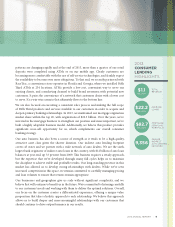Fifth Third Bank 2013 Annual Report Download - page 21
Download and view the complete annual report
Please find page 21 of the 2013 Fifth Third Bank annual report below. You can navigate through the pages in the report by either clicking on the pages listed below, or by using the keyword search tool below to find specific information within the annual report.MANAGEMENT’S DISCUSSION AND ANALYSIS OF FINANCIAL CONDITION AND RESULTS OF OPERATIONS
19 Fifth Third Bancorp
such as re-defining the regulatory capital elements and minimum
capital ratios, introducing regulatory capital buffers above those
minimums, revising the agencies’ rules for calculating risk-weighted
assets and introducing a new Tier I common equity ratio. In July of
2013, U.S. banking regulators approved the final enhanced
regulatory capital rules (Basel III Final Rule), which included
modifications to the proposed rules. The Bancorp continues to
evaluate the Basel III Final Rule and its potential impact. For more
information on the impact of the regulatory capital enhancements,
refer to the Capital Management section of MD&A.
On December 10, 2013, the banking agencies finalized section
619 of the DFA known as the Volcker Rule, which becomes
effective April 1, 2014. Though the final rule is effective April 1,
2014, the Federal Reserve has granted the industry an extension of
time until July 21, 2015 to conform activities to be in compliance
with the Volcker Rule. It is possible that additional conformance
period extensions could be granted either to the entire industry, or,
upon request, to requesting banking organizations on a case-by-case
basis. The final rule prohibits banks and bank holding companies
from engaging in short-term proprietary trading of certain securities,
derivatives, commodity futures and options on these instruments
for their own account. The Volcker Rule also restricts banks and
their affiliated entities from owning, sponsoring or having certain
relationships with private equity and hedge funds. Exemptions are
provided for certain activities such as underwriting, market making,
hedging, trading in certain government obligations and organizing
and offering a hedge fund or private equity fund. Fifth Third does
not sponsor any private equity or hedge funds that, under the final
rule, it is prohibited from sponsoring. As of December 31, 2013, the
Bancorp had approximately $181 million in interests and
approximately $80 million in binding commitments to invest in
private equity funds that are affected by the Volcker Rule. It is
expected that over time the Bancorp may need to sell or redeem
these investments although it is likely that these investments will be
reduced over time in the ordinary course before compliance is
required.
In November 2010, the FDIC implemented a final rule
amending its deposit insurance regulations to implement section 343
of the Dodd-Frank Act providing for unlimited deposit insurance
for noninterest-bearing transaction accounts for two years starting
December 31, 2010. The FDIC did not charge a separate
assessment for the insurance unlike the previous Transaction
Account Guarantee Program. Beginning January 1, 2013,
noninterest-bearing transaction accounts are no longer insured
separately from depositors’ other accounts at the same insured
depository institution.
On January 7, 2013, the BCBS issued a final international
standard for the LCR for large, internationally active banks, which
would phase in the LCR beginning in 2015 with full implementation
in 2019. In addition, the BCBS plans on introducing the NSFR final
standard in the next two years. On October 24, 2013, the U.S.
banking agencies issued an NPR that would implement a LCR
requirement for U.S. banks that is generally consistent with the
international LCR standards for large, internationally active banking
organizations, generally those with $250 billion or more in total
consolidated assets or $10 billion or more in on-balance sheet
foreign exposure, and a Modified LCR for BHCs with at least $50
billion in total consolidated assets that are not internationally active,
like Fifth Third. The NPR was open for public comment until
January 31, 2014. Refer to the Liquidity Risk Management section in
MD&A for further discussion on these ratios.
On July 31, 2013, the U.S. District Court for the District of
Columbia issued an order granting summary judgment to the
plaintiffs in a case challenging certain provisions of the FRB’s rule
concerning electronic debit card transaction fees and network
exclusivity arrangements (the “Current Rule”) that were adopted to
implement Section 1075 of the Dodd-Frank Act, known as the
Durbin Amendment. The Court held that, in adopting the Current
Rule, the FRB violated the Durbin Amendment’s provisions
concerning which costs are allowed to be taken into account for
purposes of setting fees that are reasonable and proportional to the
costs incurred by the issuer and therefore the Current Rule’s
maximum permissible fees were too high. In addition, the Court
held that the Current Rule’s network non-exclusivity provisions
concerning unaffiliated payment networks for debit cards also
violated the Durbin Amendment. The Court vacated the Current
Rule, but stayed its ruling to provide the FRB an opportunity to
replace the invalidated portions. The FRB has appealed this
decision. If this decision is ultimately upheld and/or the FRB re-
issues rules for purposes of implementing the Durbin Amendment
in a manner consistent with this decision, the amount of debit card
interchange fees the Bancorp would be permitted to charge likely
would be reduced. Refer to the Noninterest Income subsection of
the Statements of Income Analysis section of MD&A for further
information regarding the Bancorp’s debit card interchange revenue.
























